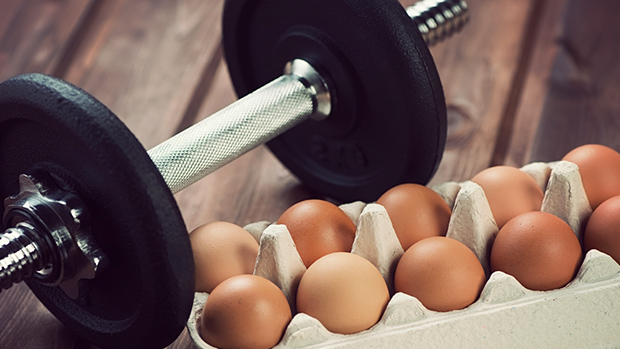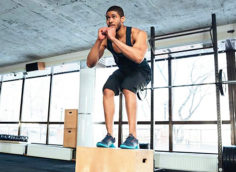My favorite questions about training come from real people. When I say "real," I don't mean that it's usually comic superheroes or hobbits that email me; I'm talking about those great men and women who hold real jobs, serve the community, and love to train.
I feel like I can address their issues. I've been the guy with two full-time professions (high school teacher and college instructor), as well as coaching athletes, competing, raising two daughters, and living a great life with my wife, Tiffini.
Recently, a guy even suggested that I must've been given extra hours in the week to do all the things I do, but honestly, there are secrets to surviving (and thriving) at trying to do "everything" as well as training and competing at a high level.
Now, these principles aren't for everyone. I got an "anonymous" post on my blog last week when I talked about some friends of mine who died in Afghanistan. Mr. Anonymous found fault with this and noted, "I thought this was a fitness site." I'm reminded of the 14-year-old who attacked one of T Nation's most famous coaches repeatedly until it was discovered that, well, he was a 14 year-old jerk. So, not everything I write is for everyone.
One of my secrets for busy people is simply this: Train three days a week, but make sure two of the days are back to back. The third day is focused on a weak movement or a full body lift that will challenge you, but not make you dip too deeply into your recovery.
Having two days off between each training cluster seems to help people train heavy and hard. But to train this way, there has to be focus on the other key elements to a total training program.

Brilliant at the Basics
Let's get through the basics first. Let's start with food. I'm a firm believer that a menu for every meal is going to save you more time, energy, and emotional breakdowns than anything else I can advise. Honestly, it doesn't matter much how you construct a menu, but the genius behind a menu is that it makes shopping easier!
So, for the past few years we've used a simple menu that usually rotates between three basic things: a grill night, followed by a chicken "with something" evening, followed by a kind of stew.
So, here are six nights of main dishes:
- Monday: Steak and salad with veggies.
- Tuesday: Chicken with rice and veggies.
- Wednesday: Jambalaya. Prep this the night before and let it slow cook all day.
- Thursday: Meat Fest! (Grill everything in sight plus any veggies worthy of the grill. I toss in pineapple and peaches as a dessert.)
- Friday: Chicken enchiladas.
- Saturday: Pot roast or stew. Again, slow cook this all day.
- Sunday: This is often a communal meal with friends and/or family.
For breakfasts, switch between egg meals and slow cooked oatmeal, and lunches depend on the situation – school, jobs, and life. (Hey, I can't answer everything in every article!)
If you don't like the menu, that's okay, just focus on the point: if you have the right items and a plan, making excellent meals is easy.
On Wednesday and Saturday, I tend to prep the meal, turn on the crock-pot, and leave for the day. For the busy person, I'd also recommend training on these days. The upside of the crock-pot is that your meal is ready when you walk in the door; simply scoop and serve. Any mental energy you have in reserve after a long day of work, chores, life, or whatever can then be steered into training.
Ever since Josh Hillis told me that the secret to long-term fat loss is substituting two training sessions a week for food shopping and food preparation, I've been looking at journals and listening to people about their struggles to "do it all."
If a secret formula to doing it all exists, I'd argue that it begins with making and posting a shopping list. First, you shop, then you prep, then you cook, and then you eat. If you get this progression right, good things tend to happen!
This is our shopping list that's attached to the fridge by a magnet (I took off items like toilet paper, toothpaste, and hygiene products, but I use them, too):
The Shopping List
- Poultry
- Sausage
- Bacon
- Fish
- Shellfish
- Canned tuna
- Salmon (in the can or fresh)
- Eggs (buy them in the five-dozen containers)
- Heavy cream, for coffee
- Real butter
- Cheese
- Salad greens: everything you can eat raw!
- Vegetables (I use frozen bags often, but fresh whenever I can)
- Lemons and limes to sweeten drinks and squeeze on fish and salads
- Herbs/spices
- Olive oil
- The best "in-season" fruit
We keep some rice on hand for filler and side dishes, but we don't do much in the way of pasta and breads. I'm not judging here, but I think as one ages, it seems to help to cut out the cheap grains.
For the busy "real" person, shopping and preparing food is training. Oh, I know, we all have the discipline of monks when it comes to what we're "going to eat." The problem with most of us is what we actually "ate."
I've been suggesting for years that people approach food with a vision beyond the pure present and think about the past, present, and future when addressing nutrition.
So, I suggest shopping twice a week – a big full shop like you're preparing to go around the world and a second shop where you just replenish perishables and pick up the things you forgot during the first shop.
The busier you are, the more important shopping and preparing food becomes. Why? Because over time, to repeat, it's what you ate that makes you fitter or fatter, not this glorious diet of things you're going to eat.
Trust me, poor food planning directly leads to poor food choices. You can't out run, out bike, or out Zumba several years of tossing piles of sugary food sacrifices on the fires of your hunger.

The Heavy Stuff
After you plan your menu, shop early, and spend a little time on prepping, you still need to make time to train. For years I've argued the following for busy people:
- Train three days a week. One of the days is going to be tight on schedule, so I suggest only doing one lift that day. Choose wisely! More on that below.
- Corrective exercises, foam rolling, other pre-hab and rehab work, as well as restorative things like hot tubbing can be done all the other days of the week.
- On the days you do train, have your food ready to eat soon after you finish.
- Training two days in a row and recovering for two full days seems to work for most working people.
So, the details:
One day a week, I suggest doing just one lift. Now, the most popular article I ever wrote at T Nation was my One Lift a Day article.
My career as an Olympic lifter was resurrected when I finally realized what would be among my greatest insights: "If I'm only doing one thing today, I might as well put everything into it."
- Clean and Press. I once wrote, "If all you did was clean and press, you could be awesome." Someone actually tried this and emailed me and to tell me that it didn't work. I didn't know how to explain to him that I was writing in a style known as "hyperbole," but the clean and press really is a one-stop shop to awesomeness. Look at photos of lifters from the 1960's who employed that lift extensively and note their massive shoulders and upper body development and realize that this would still work. I recommend a barbell, but I made very solid gains with the kettlebell following Pavel's "Rite of Passage" workout.
- Front Squat. I'm still convinced that the front squat is the best whole body lift for most people. If I'm only doing one lift and it's front squats, I feel like I'm ahead of the curve.
- Power Snatch and Overhead Squat Combo. Tony Nielson, a young man I coached for a few years, was the smallest football player on the field, yet I watched him run for 200+yards in several games. He told me it was this combo move that made the difference and he called it simply, "The Exercise." It's a full body movement and the tension you need to hold the lift trains you in the skills of the super strong.
- Dragging a sled, pushing a car, or hill sprints. If you're short on time, do these at a high intensity. It's the toughest thing I know with the most benefit or "bang for the buck."
- Farmer Walks. I've often challenged people to explore the limits of their physical capabilities with the simple farmer walks. I once did 165 pounds per hand for a competition and felt lousy for days. It's hard to describe the combination of pain, discomfort, and intensity that heavy, long, farmer walks can breed in you.
Equipment needs for all these options are minimal and can be done in or from the garage. This is how I've trained for over three decades.
Addressing the other two days a week involves thinking long term about the goals and the approach to training. The following is a program used by a strongman I trained years ago with two young children. It's best suited for someone who has some time on the weekends and not much the rest of the week:
Strongman
- Lift Day
- Power snatch
- Power clean
- Front squat
- One-arm lifts (clean and press to max each hand)
My notes to him: "Whatever reps and sets you like – I like 3 x 3 or 2 x 5 or singles (after warm-ups). These are the 'meat' sets."
- Sunday: Strongman Day
- Power clean and press (Singles up to a max)
- Sled dragging, car pushing, hill sprints
- Anything else you need to do with the equipment you have
- Farmer walks (death march style: one set to exhaustion)
- Wednesday (or one other day a week)
- One lift: Power clean and press, or power snatch and overhead squat, or front squat (He wanted to handle more so we did two lifts on the One Lift a Day workout.)
- Some kind of carry: Farmer walks or variation
That's it.

Olympic Lifter
I also adapted this for an Olympic lifter. O-lifters would do the classic lifts on perhaps Saturday, and the power moves and squats on Sunday, with the "other" workout being an 80 percent (or less) total day.
Here's an example.
- Wednesday
- Light Total: Snatch and the clean and jerk
- Saturday
- Snatch
- Clean and jerk
- Front squats
- Farmer walks
- Sunday
- Power snatch
- Power clean
- Push jerk
- Back squat
Thrower
Highland Gamers often email me about programs where you mix a busy professional life and training. I usually recommend adding as much throwing as you can do, but one nice thing is that the Heavy Weight for Distance seems to help the Light Weight for Distance, the Heavy Hammer and the Light Hammer complement each other, and the Braemar supports the Stone Put.
The caber, in my experience, is best served by doing the Olympic lifts and sled pulls as well as getting some experience in a lot of games. I've had one or two people tell me that competing in a Highland Games on Saturday, lifting on Sunday (brave lad indeed!), followed by a single lift and some work on a few events on Wednesdays is one way to balance life and an addiction to HGs.
Powerlifter
From some advice from Pavel, I was able to construct a powerlifting variation that actually works well for many lifters with too much life on their hands.
- Wednesday
- Bench press (This is why people love this program)
- Saturday
- Back squat (but every few weeks, deadlift. Most people don't need as much training on the deadlift)
- Bench press
- Sunday
- Deadlift, squat, and bench press assistance exercises
Obviously, you can set this up with having the two double days back to back on Monday or Tuesday with the single lift day on Friday. On this system you enjoy a free weekend, but still follow the same principles.
Putting It All Together
Here's an example of a typical week with all the plumbing.
- Monday
- Shop and do some basic cooking prep for the week
- Restoratives, if necessary
- Tuesday
- Restoratives, if necessary
- Prepare dinner for the next day
- Wednesday
- One Lift (Front squats or whatever)
- Thursday
- Second shop of the week, if necessary
- Restoratives, if necessary
- Friday
- Prepare the dinner for the next day (Or, you can BBQ after you train on Saturday, but still prep the food)
- Saturday
- Power snatch
- Front squat
- One-arm clean and press
- Farmer walks
- Sunday
- Press variation
- Power clean
- Overhead squat
- Sled dragging, car pushing, or hill sprints
Wrap Up
I admit, there's a lot of information missing, such as reps, sets, and choosing the appropriate load. What I did cover, however, is the important stuff that busy folks need to get a handle on before they can really improve their physiques.
To that end, my goal here wasn't to present the Greatest Workout of All Time or The Ultimate 8 Meals a Day Super Diet, but to combine a real life scenario and reasonable training principles.
And reasonable is a lost art in the world of fitness.





